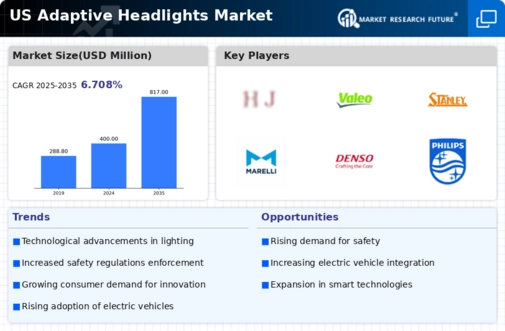Rising Vehicle Production
The adaptive headlights market is experiencing growth due to the increasing production of vehicles in the US. As manufacturers strive to enhance vehicle safety and performance, the integration of advanced lighting systems, including adaptive headlights, becomes a priority. In 2025, the automotive industry in the US is projected to produce over 15 million vehicles, with a significant portion incorporating adaptive lighting technologies. This trend indicates a shift towards more sophisticated vehicle features, which is likely to drive demand for adaptive headlights. Furthermore, as consumers become more aware of the benefits of adaptive lighting, such as improved visibility and reduced glare, the market for these systems is expected to expand. The adaptive headlights market is thus poised for growth as vehicle production continues to rise, reflecting a broader trend towards innovation in automotive design.
Increased Focus on Road Safety
The adaptive headlights market is significantly influenced by the heightened emphasis on road safety in the US. With traffic accidents being a leading cause of fatalities, there is a growing demand for technologies that enhance visibility and reduce accidents. Adaptive headlights, which adjust their beam patterns based on driving conditions, are seen as a crucial innovation in improving nighttime driving safety. According to the National Highway Traffic Safety Administration, adaptive lighting systems can potentially reduce accidents by up to 30%. This statistic underscores the importance of adaptive headlights in the broader context of road safety initiatives. As regulatory bodies and safety organizations advocate for the adoption of such technologies, the adaptive headlights market is likely to benefit from increased investments and consumer interest in safety-enhancing features.
Consumer Preferences for Premium Features
The adaptive headlights market is also being driven by changing consumer preferences towards premium vehicle features. As consumers increasingly prioritize comfort, safety, and advanced technology in their vehicle purchases, adaptive headlights are becoming a sought-after option. In 2025, surveys indicate that nearly 40% of consumers are willing to pay a premium for vehicles equipped with advanced lighting systems. This willingness to invest in safety and convenience features suggests a growing market for adaptive headlights. Additionally, as more automakers offer these systems as standard or optional features, the adaptive headlights market is likely to see a surge in demand. This trend reflects a broader shift in consumer behavior, where the value placed on innovative safety technologies is influencing purchasing decisions.
Government Incentives for Safety Technologies
The adaptive headlights market is benefiting from government incentives aimed at promoting safety technologies in vehicles. Various federal and state programs are encouraging manufacturers to adopt advanced safety features, including adaptive headlights, through tax credits and grants. These initiatives are designed to reduce traffic fatalities and improve overall road safety. In 2025, it is anticipated that funding for automotive safety programs will exceed $500 million in the US, providing a substantial boost to the adaptive headlights market. As manufacturers respond to these incentives by integrating adaptive lighting systems into their vehicles, the market is likely to experience accelerated growth. This alignment of government policy with industry innovation underscores the potential for adaptive headlights to play a pivotal role in enhancing vehicle safety.
Technological Integration in Automotive Design
The adaptive headlights market is being propelled by the integration of advanced technologies in automotive design. As vehicles become more connected and automated, the demand for sophisticated lighting systems that can adapt to various driving conditions is increasing. Innovations such as LED and laser lighting technologies are being incorporated into adaptive headlights, enhancing their efficiency and performance. In 2025, it is estimated that the market for LED headlights alone will reach approximately $10 billion in the US, indicating a robust growth trajectory. This technological evolution not only improves visibility but also aligns with consumer preferences for modern, high-tech vehicles. The adaptive headlights market is thus benefiting from this trend, as manufacturers seek to differentiate their products through cutting-edge lighting solutions.






















Leave a Comment